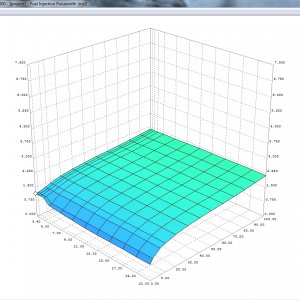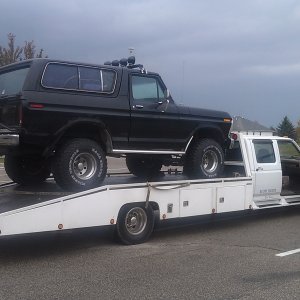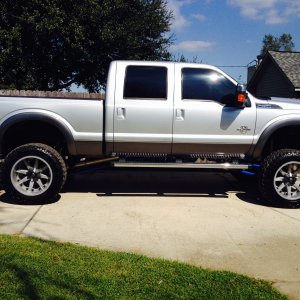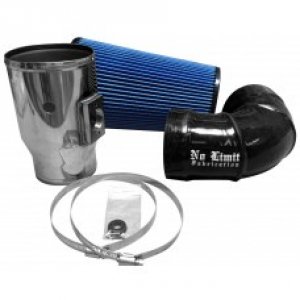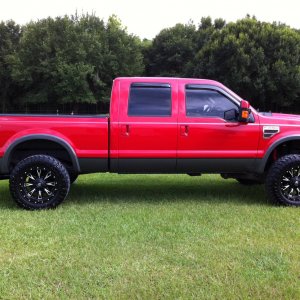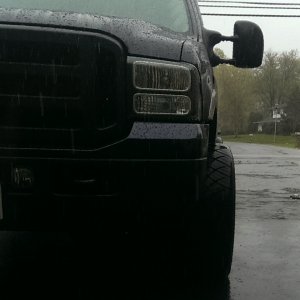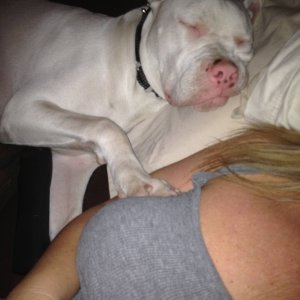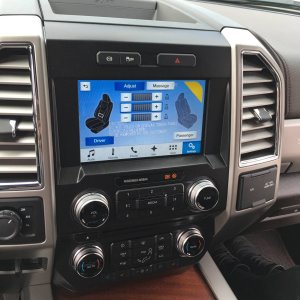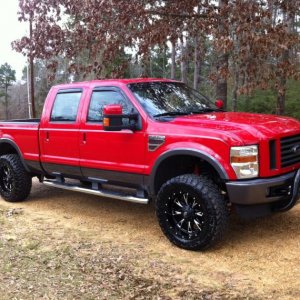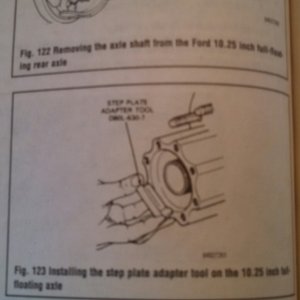You are using an out of date browser. It may not display this or other websites correctly.
You should upgrade or use an alternative browser.
You should upgrade or use an alternative browser.
FFD Rail System
- Thread starter njjeep
- Start date
Hotrodtractor
Moderator
Don’t forget Viagra.
Excellent example (I was unaware, but I Googled it and learnt me sumtin).
Since my request has been fulfilled - I shall oblige. Thank you - Tamisha was ecstatic.
This whole debate can be boiled quite succinctly down into two issues:
1) Does this thing actually improve performance? Cass said he has evidence to support that it does with improvement in several test trucks as well as years of experience with these trucks. I'm inclined to give him the benefit of the doubt - its no secret that we've known each other for years and consider each other friends. I eagerly await the presentation of said evidence with the rest of you.
2) How does it work? I don't have a a concrete answer on that - but I do have theories which I will outline in a moment. First I'll post a paraphrase of what I told Cass "I know for a fact its not that bull**** you posted on the FB ad" ..... Maybe that isn't actually paraphrasing.... LOL
Theory 1: Firstly - we need to dispel a myth that I have seen repeated in this thread numerous times. Engine oil is compressible. That is a FACT. This is especially true when it comes to aerated oil which is pretty much the only thing that exists in a 7.3L Powerstroke. These rails take up a known volume of the factory "reservoir" giving less volume to be compressed. This could be a method of stabilizing the pressure.
Theory 2: This would be my front runner theory, but its more of an educated guess. These inserts actually dampen the pressure waves that are taking place within the oil rail. Fluid harmonics in a transient flow like this are a PITA. By inserting this device into the oil rail its giving a new surface for the pressure waves mostly being generated by the starting and stopping of oil flow at each individual injector a new surface to bounce off of and dissipate.
Theory 3: I don't have one.... but that doesn't mean there isn't yet another undiscovered mode where this device could improve the rails. If you have theory where this might work - please share.
In any case - if the tech performs as advertised regardless of the the actual physics behind the why it works - that might be what truly matters. While the fluid mechanics of the initial theory that lead FFD down the path to develop this might be fundamentally flawed, it is quite possible that they have stumbled onto something unique and quite worthy of the small price they are asking (compared to anything else for these engines). I think we often forget that sometimes some great things are discovered entirely by accident. Corn Flakes, Teflon, Post-It Notes (the adhesive), silly putty, etc.... were all things created in the pursuit of something else.
That is my take on this. Does it work? Maybe. How does it work? Not as its advertised currently.
I've thought about the theory 1 you've listed as well. At 3000 psi generic motor oil will compress about 1% of original volume (more if its aerated). Less volume would be easier to compress but the problem still remains that the only volume that needs to be compressed is what is lost through the firing of the injectors.
A similar system to turn to in that regard would be the typical air compressor setup. They utilize large tanks to store large quantities of compressed air to supply quantities of air that the pump alone would not be able to immediately supply on its own. The great thing about compressible fluids is that they can expand and the amount of work that they can perform is much greater than that of more in-compressible fluids. The big drawbacks however are the size of pumps necessary to maintain pressure during peak usage and the inability to rapidly adjust pressure over large volumes (increased time to reach operating conditions).
In any case, reducing the size of the tank is not beneficial for operating an air compressor (unless you're willing to sacrifice ability to do work for less startup time) nor would it be beneficial in the hpo system of these engines.
The stabilization of pressure which would be seen using these rails is from adding a restriction at the position where the pressure is measured (ICP sensor). Restriction blocks flow, increases pressure upstream, decreases flow and pressure downstream.
I'm not as familiar with the intricacies of fluid harmonics (not my area of study). I'll need to read up on it, but my initial leanings are that harmonic dampening would occur mostly at the exterior walls where energy can be lost to the surrounding environment. Placing the rail inserts inside of the oil rails would increase wall surface area but not exterior walls. Any energy absorbed by the rail inserts would just as easily be passed right back into the oil. Solids translate compression energy quite well. In confined volumes liquids do as well, yet gases are very poor (notice the trend from highly incompressible to highly compressible!).
I'm still very interested to see data on the subject, and would very much like to see a penicillin-like discovery take place! Like you said, results speak for themselves. Again, as has been previously mentioned, I hope that the experimental process is rigorous for data collection because most physical explanations for the effect don't add up.
Last edited:
Swaan
New member
- Joined
- Mar 19, 2012
- Messages
- 734
- Reaction score
- 0
I'd like to see data from a third party before I took it as facts.
I'm not saying ffd is not credible just unbiased test results is always more beneficial. So far everything is leaning towards a bunk product from a scientific stand point.
I'm not saying ffd is not credible just unbiased test results is always more beneficial. So far everything is leaning towards a bunk product from a scientific stand point.
Hotrodtractor
Moderator
I've thought about the theory 1 you've listed as well. At 3000 psi generic motor oil will compress about 1% of original volume (more if its aerated). Less volume would be easier to compress but the problem still remains that the only volume that needs to be compressed is what is lost through the firing of the injectors.
Correct to a point - yes the exact volume that needs to flow out of the HPOP and into the rails and ultimately to any one injector and any given time is exactly the volume of oil the injector is consuming while injecting diesel fuel. My statement about stabilizing pressure because of the lower volume revolved more around the internal pressure waves inside the rail caused by transient nature of of the flows within the lines and rails.
A similar system to turn to in that regard would be the typical air compressor setup. They utilize large tanks to store large quantities of compressed air to supply quantities of air that the pump alone would not be able to immediately supply on its own. The great thing about compressible fluids is that they can expand and the amount of work that they can perform is much greater than that of more in-compressible fluids. The big drawbacks however are the size of pumps necessary to maintain pressure during peak usage and the inability to rapidly adjust pressure over large volumes (increased time to reach operating conditions).
In any case, reducing the size of the tank is not beneficial for operating an air compressor (unless you're willing to sacrifice ability to do work for less startup time) nor would it be beneficial in the hpo system of these engines.
While there are some parallels - I don't think this analogy holds for this. The main difference being that air is highly compressible. When I am talking with a customer about installing industrial equipment - I always recommend an air accumulator with a check valve to isolate the accumulator from the plant lines. In some instances the machine/device can operate entirely on the stored energy of the accumulator for a single cycle before more the plant's system can recover and charge the local accumulator tank. The rails are not there for storage of compressed, pressurized oil, they are sized to take care of specific hydraulic harmonics as laid out in a stock application in the early 1990s. A lot of things have changed since then, and with the modifications we are now doing, I know the harmonics are different.
There has been testing in the past of utilizing small hydraulic accumulators with some promising results, but that was at least a dozen plus years ago and I have no idea where that information has gotten to....
The stabilization of pressure which would be seen using these rails is from adding a restriction at the position where the pressure is measured (ICP sensor). Restriction blocks flow, increases pressure upstream, decreases flow and pressure downstream.
The way this is designed - it doesn't block or restrict flow - it simply takes up volume in the middle of a quite large oil reservoir. It might redirect flow a bit going from the oil feed lines to the injectors, but it doesn't block or restrict that flow.
I'm not as familiar with the intricacies of fluid harmonics (not my area of study). I'll need to read up on it, but my initial leanings are that harmonic dampening would occur mostly at the exterior walls where energy can be lost to the surrounding environment. Placing the rail inserts inside of the oil rails would increase wall surface area but not exterior walls. Any energy absorbed by the rail inserts would just as easily be passed right back into the oil. Solids translate compression energy quite well. In confined volumes liquids do as well, yet gases are very poor (notice the trend from highly incompressible to highly compressible!).
I don't claim to be an expert either - but I do deal with it in some form almost on a daily basis. While the insert wouldn't absorb the energy - it could very easily redirect it and distribute it better dissipating the pressure wave. Totally a theory - I could set up a model and run the analysis, but quite frankly that's too much work to not get paid to do. LOL
I'm still very interested to see data on the subject, and would very much like to see a penicillin-like discovery take place! Like you said, results speak for themselves. Again, as has been previously mentioned, I hope that the experimental process is rigorous for data collection because most physical explanations for the effect don't add up.
Agreed - data will make or break this. Not the explanation of how the the why - just that it does.
Arisley
Moderator
Some things we just have to come up with theories and accept that we think we know why it works. Best example of that I can think of off the top of my head is electricity. When I went to school for electronics, it was to learn the theory of electronics. Not the PROOF of electronics. Which means that we think we know how electricity works.
While there are some parallels - I don't think this analogy holds for this. The main difference being that air is highly compressible. When I am talking with a customer about installing industrial equipment - I always recommend an air accumulator with a check valve to isolate the accumulator from the plant lines. In some instances the machine/device can operate entirely on the stored energy of the accumulator for a single cycle before more the plant's system can recover and charge the local accumulator tank. The rails are not there for storage of compressed, pressurized oil, they are sized to take care of specific hydraulic harmonics as laid out in a stock application in the early 1990s. A lot of things have changed since then, and with the modifications we are now doing, I know the harmonics are different.
There has been testing in the past of utilizing small hydraulic accumulators with some promising results, but that was at least a dozen plus years ago and I have no idea where that information has gotten to....
The way this is designed - it doesn't block or restrict flow - it simply takes up volume in the middle of a quite large oil reservoir. It might redirect flow a bit going from the oil feed lines to the injectors, but it doesn't block or restrict that flow.
I don't claim to be an expert either - but I do deal with it in some form almost on a daily basis. While the insert wouldn't absorb the energy - it could very easily redirect it and distribute it better dissipating the pressure wave. Totally a theory - I could set up a model and run the analysis, but quite frankly that's too much work to not get paid to do. LOL
Agreed - data will make or break this. Not the explanation of how the the why - just that it does.
I'm not sure how to do the fancy quotes of individual parts of a post.... darn. I'll play around with that later.
Anyways, I'm not sure about the rails being used for harmonic dampening specifically, would be very interesting if that is the case, I'd like to see the paper written on that. Seems to me, the rail is a very simple (K.I.S.S.) way to manufacture a delivery system that provides oil at a given volume and pressure to 4 different injectors EQUALLY. It would be much more difficult to manufacture smaller individual passages from the injectors to individual outlets for hookup to the hpop, and routing individual lines from hpop to each injector would take up an awful amount of space on top of the engine.
As far as restricting flow, the inserts are reducing the available volume for oil to flow, the very definition of a restriction. How big of a restriction that is and if it matters, well that's debatable to be sure. Without dimensions of the rail inserts and the rail I can't really get an idea but it IS a restriction.
It could very well dissipate the wave better, I don't truly know. I did some light reading on hydraulic shock at work and from what I saw LARGER pipe diameters usually dissipate pressure waves better (from work by Newton-Laplace). This makes sense to me because the wave has more volume to move through and lose energy to heat through shear forces.
I would love to see a model, but you're right about it not being worth it if you're not getting paid! Though to be honest, I would probably enjoy making that model more than the ones I'm currently working on, and it might be more useful too! Haha
Personally, I'd like to be able to explain the physical phenomena that we witness because that allows it to be adapted, used for other systems, and commercialized more effectively. Not to mention that accurately explaining how/why something works gives peace of mind to the consumer and helps sell the product.
Last edited:
Hotrodtractor
Moderator
I'm not sure how to do the fancy quotes of individual parts of a post.... darn. I'll play around with that later.
Anyways, I'm not sure about the rails being used for harmonic dampening specifically, would be very interesting if that is the case, I'd like to see the paper written on that. Seems to me, the rail is a very simple (K.I.S.S.) way to manufacture a delivery system that provides oil at a given volume and pressure to 4 different injectors EQUALLY. It would be much more difficult to manufacture smaller individual passages from the injectors to individual outlets for hookup to the hpop, and routing individual lines from hpop to each injector would take up an awful amount of space on top of the engine.
As far as restricting flow, the inserts are reducing the available volume for oil to flow, the very definition of a restriction. How big of a restriction that is and if it matters, well that's debatable to be sure. Without dimensions of the rail inserts and the rail I can't really get an idea but it IS a restriction.
It could very well dissipate the wave better, I don't truly know. I did some light reading on hydraulic shock at work and from what I saw LARGER pipe diameters usually dissipate pressure waves better (from work by Newton-Laplace). This makes sense to me because the wave has more volume to move through and lose energy to heat through shear forces.
I would love to see a model, but you're right about it not being worth it if you're not getting paid! Though to be honest, I would probably enjoy making that model more than the ones I'm currently working on, and it might be more useful too! Haha
Personally, I'd like to be able to explain the physical phenomena that we witness because that allows it to be adapted, used for other systems, and commercialized more effectively. Not to mention that accurately explaining how/why something works gives peace of mind to the consumer and helps sell the product.
If I get a chance when I get home later this weekend - I think I still have some of the white papers on the initial design of the system on an old hard drive - the oil rail is WAY oversized for just pure distribution purposes. I seem to recall that specifically being in the paper where they were testing out the hydraulically operated valves on the Pike's Peak truck.... but that might be just my imagination running things together.
I have MORE than enough modeling and other cool things on my plate - I don't need to do something else just for enjoyment. LOL I have a truck that needs finished so the owner can have it and enjoy it. Might be my last thing PSD at least for a while.
I do agree that understanding and explaining the physical phenomena can lead to greater things and more varied application - but I think this particular variation might not be that directly applicable to anything else. lol
If I get a chance when I get home later this weekend - I think I still have some of the white papers on the initial design of the system on an old hard drive - the oil rail is WAY oversized for just pure distribution purposes. I seem to recall that specifically being in the paper where they were testing out the hydraulically operated valves on the Pike's Peak truck.... but that might be just my imagination running things together.
If you can find them it'd thrill me to read them. I agree on oversized for distribution, though how much I don't know, and truthfully I'd rather have it oversized than undersized! Like we've never had to deal with that kind of problem before...
For oil rail design rationale I was leaning more towards an ingeniously simple method whose size would directly translate to simplified casting and function properly for thousands of hours. Would really make my day to learn it was DESIGNED with more than that in mind (not that I'm trying to diminish the significance of those features).
ja_cain
Active member
- Joined
- Aug 10, 2013
- Messages
- 4,597
- Reaction score
- 2
I was so hoping you were going to respond to this. I could see where oversizing the rail could be a huge problem if oil aeration was a problem. Some have brought up the idea that oil is for all intents and purposes incompressable compared to gas, but that's in a perfect world where we don't have imperfect, old and leaky systems. Can't wait to see these white papers!!If I get a chance when I get home later this weekend - I think I still have some of the white papers on the initial design of the system on an old hard drive - the oil rail is WAY oversized for just pure distribution purposes. I seem to recall that specifically being in the paper where they were testing out the hydraulically operated valves on the Pike's Peak truck.... but that might be just my imagination running things together.
I have MORE than enough modeling and other cool things on my plate - I don't need to do something else just for enjoyment. LOL I have a truck that needs finished so the owner can have it and enjoy it. Might be my last thing PSD at least for a while.
I do agree that understanding and explaining the physical phenomena can lead to greater things and more varied application - but I think this particular variation might not be that directly applicable to anything else. lol
Sent from my SM-G930V using Tapatalk
Last edited:
I will be testing this shortly with a handful of reputable tuners on our dyno with my personal truck that has 350/200. Right now im just rocking a used stage 1 CNC hpop that works for the most part except race tunes and full WOT hits.
Does anyone has any special requests ?
Might even try change up injectors as well.. but that becomes expensive. Just to keep a experiment controlled .
I also have two sets of twins sitting here that i will be putting back on afterward.
Does anyone has any special requests ?
Might even try change up injectors as well.. but that becomes expensive. Just to keep a experiment controlled .
I also have two sets of twins sitting here that i will be putting back on afterward.
Last edited:
Zeb
New member
I will be testing this shortly with a handful of reputable tuners on our dyno with my personal truck that has 350/200. Right now im just rocking a used stage 1 CNC hpop that works for the most part except race tunes and full WOT hits.
Does anyone has any special requests ?
Might even try change up injectors as well.. but that becomes expensive. Just to keep a experiment controlled .
I also have two sets of twins sitting here that i will be putting back on afterward.
Been hoping you’d chime in.
I know you guys have been doing a lot of dyno testing with FF injectors, and couldn’t imagine that their rail system hadn’t been talked about.
Definitely interested to see the results!
psduser1
Well-known member
For testing purposes, dont swap tuners around, imo.I will be testing this shortly with a handful of reputable tuners on our dyno with my personal truck that has 350/200. Right now im just rocking a used stage 1 CNC hpop that works for the most part except race tunes and full WOT hits.
Does anyone has any special requests ?
Might even try change up injectors as well.. but that becomes expensive. Just to keep a experiment controlled .
I also have two sets of twins sitting here that i will be putting back on afterward.
Just run "x" tuner throughout, and post the results.
I'd like to see gross change, with this mod, and I think changing tuners will only muddy the waters, so to speak. A 200% nozzle should be a decent compromise for aftermarket injectors, for a baseline.
Obviously, smaller nozzles, different tuners, results may vary, but for internet purposes, keep it simple, once again, imo.
Strokersace
Well-known member
For testing purposes, dont swap tuners around, imo.
Just run "x" tuner throughout, and post the results.
I'd like to see gross change, with this mod, and I think changing tuners will only muddy the waters, so to speak. A 200% nozzle should be a decent compromise for aftermarket injectors, for a baseline.
Obviously, smaller nozzles, different tuners, results may vary, but for internet purposes, keep it simple, once again, imo.
Agree 100%. This is what is so challenging with their turbo and injector testing. It’s never just turbo upgrade or injector upgrade, there is always tuning or tuner changing as well.
Just change one thing, and report back the before and after.
Hotrodtractor
Moderator
I'll mimic what others are saying..... keep variables small.
Run whatever select set of tunes that you would like - run them from different tuners and collect that data for baselines.
Install the rail.
Run the exact same tunes for a one on one comparison to see an improvement.
THEN - make whatever tuning changes you would like due to the rail and run those for comparison.
Even more interesting then would be to remove the rails and run your "updated tuning"
Just food for thought from a guy on the sidelines.
Run whatever select set of tunes that you would like - run them from different tuners and collect that data for baselines.
Install the rail.
Run the exact same tunes for a one on one comparison to see an improvement.
THEN - make whatever tuning changes you would like due to the rail and run those for comparison.
Even more interesting then would be to remove the rails and run your "updated tuning"
Just food for thought from a guy on the sidelines.
ja_cain
Active member
- Joined
- Aug 10, 2013
- Messages
- 4,597
- Reaction score
- 2
Good stuff Jason. When I am validating new rigs at work I only manipulate one knob at a time and then collect data or the changes in one variable may confound/mask the changes in the other and you won't know what's going on. I also like to make gross adjustment to this knob (if safe) so I can bookend the responses. Then I will go with a middle of the road adjustment to see if there is a linear (or whatever) relationship. Hope this makes sense.
Last edited:
lincolnlocker
Well-known member
Run whatever tuning drops the most icp at wot or on the dyno. Get baseline numbers and install the ffd rails only. Then repeat test. If it holds icp better then we know it works. Keep it simple at first. Then start changing other chit.I will be testing this shortly with a handful of reputable tuners on our dyno with my personal truck that has 350/200. Right now im just rocking a used stage 1 CNC hpop that works for the most part except race tunes and full WOT hits.
Does anyone has any special requests ?
Might even try change up injectors as well.. but that becomes expensive. Just to keep a experiment controlled .
I also have two sets of twins sitting here that i will be putting back on afterward.
live life full throttle
For testing purposes, dont swap tuners around, imo.
Just run "x" tuner throughout, and post the results.
I'd like to see gross change, with this mod, and I think changing tuners will only muddy the waters, so to speak. A 200% nozzle should be a decent compromise for aftermarket injectors, for a baseline.
Obviously, smaller nozzles, different tuners, results may vary, but for internet purposes, keep it simple, once again, imo.
in our testing we always keep the variables the same, we literally dont even change the tune and it literally is the same tunes on t4 and drop in truck since they are both PMT computers. Charlie is very picky on that stuff and keeping tests controlled.
I plan on just throwing my truck up on the dyno with the current tunes (ill use 3 different tuners files *race files*) and get a baseline and then install it and run it again. I will most likely reach out to all my tuners for revisions before it all happens as well so we can get tuning comparisons data on the dyno as well.
Last edited:
Run whatever tuning drops the most icp at wot or on the dyno. Get baseline numbers and install the ffd rails only. Then repeat test. If it holds icp better then we know it works. Keep it simple at first. Then start changing other chit.
live life full throttle
Actually, as argued earlier in this thread part of this discussion is based around whether the FFD rails would actually deliver more oil to the injector or result in a sustained ICP reading without delivering more oil. In the former situation a problem is solved, in the later the problem is masked.
Measuring ICP alone would not answer the question of whether these rail inserts solve the problem or mask it. The HP/TQ numbers (how well the injectors are functioning) in combination with the measured ICP are required in order to arrive at a definitive answer.
I think this is generally understood by you and others, but it just didn't come through that way in your post and I thought I would clarify.

